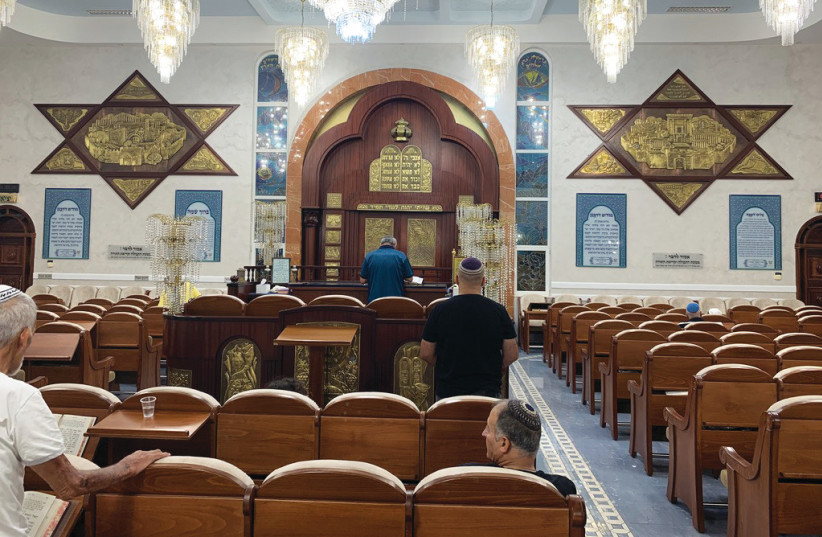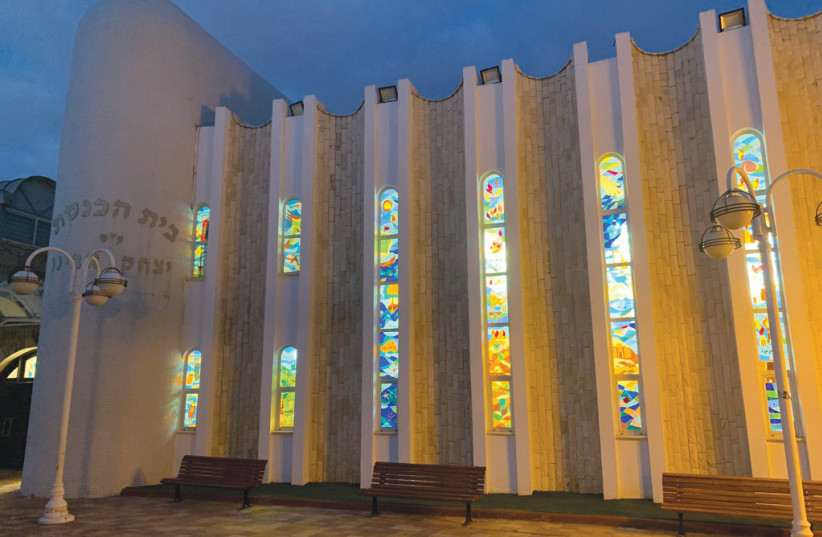Apart from the remains of a Bronze Age fortress pre-dating ancient Israelite presence, the roots of Nahariya (population 60,000) are decidedly modern and generally secular. They go no further back than 1934, when German-Jewish immigrants founded and expanded this community, which included three flourishing industrial household names: Strauss, Soglowek and Wertheimer, of the ice cream, meat-processing and precision metal-working industries, respectively.
The site of Nahariya was very likely passed over by the ancients, medievals, and pre-20th century inhabitants, as however charming and stunning its beaches are, it lacked the prime asset for a potential coastal city: a natural harbor, like nearby Acre and Tyre.
But tucked neatly behind the city’s externals, which include café life, hopeful fishermen casting lines into the surf and unforgettable sunsets through the pristine air, are well-kept, imaginatively and lovingly maintained synagogues. They lack one thing: the patina of age. For they were all established and developed within living memory. Residents include Nahariya’s founding German-Jewish immigrants from the 1930s, waves of Mizrahi immigrants in the 1950s, which were later augmented by olim from the former Soviet Union and Ethiopian, and, from 2000, many Israeli South Lebanon Army personnel who withdrew from Lebanon a very short distance away. Nahariya is thus 97% Jewish. Unlike many seaside towns that evoke retired people (such as Nahariya’s twin city, Miami Beach), it has a young population, with age demographics exemplifying Israel as a whole.
The synagogues of Nahariya
One gets the impression through the city’s synagogues that the communities live in the urbane present, though not without a healthy cognizance of their diverse roots. The Ashkenazim have the Heichal Aharon Central Synagogue, behind Ga’aton Street (south side). Southward, behind Weitzman Street, is the relatively large Yitzhak Avinu Synagogue, whose services embrace the Moroccan melodies and customs, as does the small, but impressive, Beth Meir Synagogue, behind Herzl Street. Mizrahi places of worship spread through the neighborhoods both north and south of Ga’aton Street, the river-threaded city main thoroughfare. Also worth visiting are the Eli Cohen Synagogue at 53 Kibbutz Galuyot, and the Ha’ari Ha’kadosh in the Shmulik neighborhood. The Yemenites have Etz Hahayim Synagogue on Yechiam Street. Younger people tend to find themselves at Tikvatenu on Ahad Ha’am Street; Chabad operates from its synagogue on Ga’aton Street and in the Givat Ussishkin neighborhood; and Reform worshipers have Kehilat Emet Ve-Shalom in the municipal community center on Friday evenings. The city’s only non-Orthodox synagogue, it was established in Nahariya’s earlier days by Jewish immigrants from Germany and Central Europe who formed a community using a more progressive form of religious expression, congruent with their experience in their countries of origin.
Unlike Tel Aviv and Ashdod, there are no hassidic centers: none of their leaders have made Nahariya their home. But that gap is eminently filled by the court of world-rank Kabbalist Rabbi David Abuhatzeira, of the famous Sephardi Moroccan line, whose institutions include a local full-time yeshiva and a yeshiva high school. At 27 Abir Ya’akov St., many travel to Nahariya for his readily accessible counsel and blessing and recount the good things that subsequently happen. Suitable times are 2 p.m. on Mondays, Tuesdays and Thursdays, as well as sometimes after Shabbat.
The religious council of Nahariya lists some 60 synagogues, which in this small city means that walking to see a new one each Shabbat will take you more than a year to complete. Among those that are prominent are the previously mentioned Heichal Aharon Central Synagogue, Yitzhak Avinu Synagogue and Beth Meir Synagogue.
Heichal Aharon is a modern structure. Its central place in the city expresses itself with the names of Nahariya’s fallen in Israel’s conflicts prominently inscribed on the walls of the entrance hall. It is named after the city’s first major Ashkenazi communal religious leader, Rabbi Dr. Aharon Keller (d. 1998), who, like many of the city’s founders, was of German-Jewish origin and training. Though the services are Ashkenazi, they incorporate some customs, liturgical tunes and formal mannerisms that originate in pre-Holocaust Germany, reflecting the German-Jewish roots of the town as a whole, though these are rapidly fading almost to a vanishing point. For example, until recently, major Shabbat and festival services were always led by a professional cantor rather than by lay members of the congregation. Also, as common in the Diaspora but almost unknown in Israel, Kiddush is inserted into the Friday night service before the concluding Aleinu prayer, though I have been told that the practice of giving the wine to the children ceased with COVID. Thus German-Jewish nuances have become more muted in not just the city but in the synagogue, with elderly regulars pointing at the newer born-and-bred Israeli yeshiva high-school generation having lost touch with the religious ways and customs of their forebears.
In contrast to the Jews originating from Germany, the immigrant groups with Sephardi roots seemed to have done better in supporting their practices and customs. Yitzhak Avinu Synagogue at 5 Rotem St., south of the city center, is distinctly Moroccan in character (as are most of its members) rather than the more ubiquitous Israeli Sephardi. And not just in rites and customs, but in its beautifully elaborate interior décor. Marble frames the ark, with its symbols of the 12 tribes and the seven species of the Holy Land. And two golden stars flank the ark: the left one embracing the Jerusalem of the Temple era, and the right with the Knesset, the Jerusalem of today.
Indeed, the majority of the synagogues in Nahariya are Sephardi, whose exteriors are typically plain on the outside but stunning within. Even those to whom that rite is unfamiliar should make a point of visiting one or two of their places of worship: with a special mention going to Beth Meir, north of the city center, at 8 Herzl St. With its lovingly crafted wood-paneled ark, the synagogue is superbly organized and takes pride in sincerely welcoming every person that drops in. On Shabbat, secular visitors frequently attend, attracted by the traditional yet relaxed and friendly atmosphere.
Overall, Nahariya contains a wide spectrum of synagogues to explore, and the newcomer will not run out of them soon. Notwithstanding the ice cream parlors and walks along the seafront more readily associated with the city, synagogues are, as in other regions, a good low-key environment in which to connect with the city’s residents (as long as it’s not during the services). Plenty of Torah study goes on as well in the synagogue, the religious school and in the full-time Torah-study Yeshiva environment.
I didn’t see any study groups advertised in English in contrast to the numerous ones in Jerusalem and Tel Aviv, but then the searcher may well come across some and, failing that, maybe start some! ■


